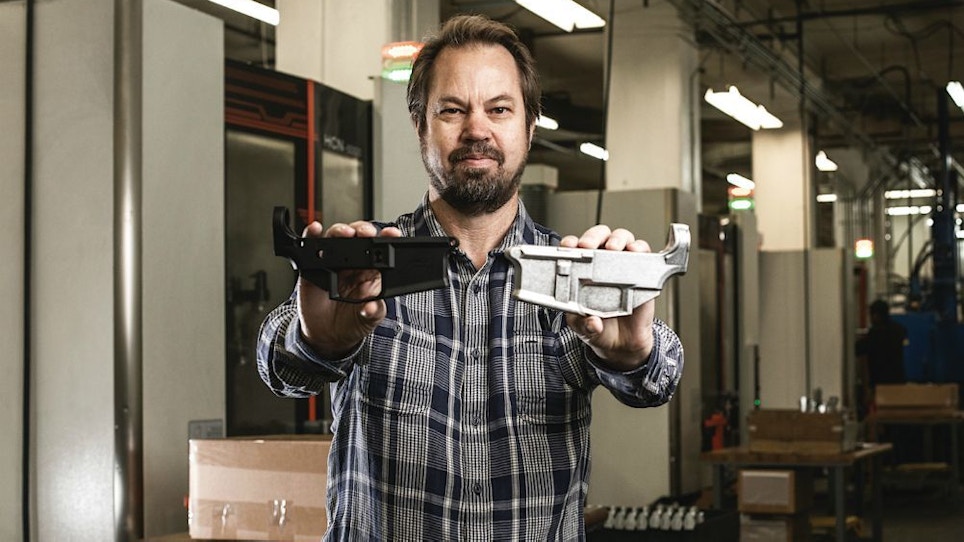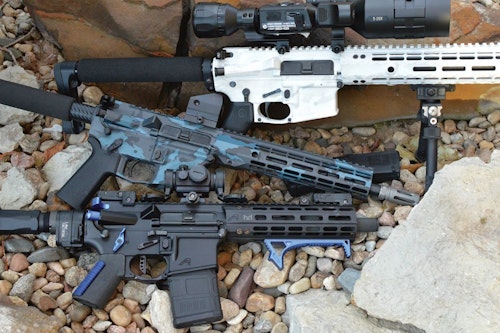The Modern Sporting Rifle (MSR) manufacturing business has exploded in an extremely short period of time. According to BATF statistics, only about 200,000 MSRs were manufactured yearly in 2007 and today that number has swelled to 1.8 million units yearly. From a manufacturer perspective, it was reported that in 2000 there were only around 29 MSR manufacturers and now that number is roughly 17 times more (about 500) and significantly more if you include smaller niche manufacturers. In a sea of “me-too” manufacturers, Aero Precision has stood out and been recognized for its consistent quality by its dealers and customers year after year.
Aero Precision’s production history started in the aerospace industry with an emphasis on automated and statistically measured high precision ISO manufacturing. That high volume, high precision production manufacturing naturally aligned to the firearms industry needs and ultimately ongoing OEM manufacturing for a multitude of brands in our industry.
I had an opportunity to talk with Aero Precision’s CEO, Scott Dover, about how Aero is continuing to drive innovation in the firearms industry.
TR — How did Aero Precision get into the firearms business?
SD — Obviously from our name, most would guess we started in aerospace manufacturing with a focus heavily in OEM Tier 1 and 2 work for Boeing and general contract manufacturing for the aerospace industry. That industry requires a difficult combination of extremely tight tolerance manufacturing, setup and production knowledge for very high-volume capabilities, all paired with efficiencies to minimize cost as well — these are all very hard things for a manufacturer to manage in combination. Generally, most manufacturers concentrate on just one or two of those goals, but because our business was built to deliver the best precision, highest volume and minimized cost, we have been able to do things most manufacturers cannot.
That aerospace experience built a strong foundation and reputation for our company in the manufacturing world. What differentiates us is holding the precision through extremely high production volumes, which ultimately drives down the price. Our entry into the firearms industry was a natural process. We bid on and were awarded some contracts in the OEM firearms space and we applied a lot of our best practices in aerospace engineering to those projects, which ultimately resulted in a change of direction for our company. It did take us a few years to really get our tooling and forgings where we wanted them, however, since then we have let customers lead the product direction.
TR — How is your manufacturing different?
SD — There are a lot of differences in how we do things. It all starts with the forgings made from U.S.-sourced materials. Unlike the majority of the industry, we work closely with our valued forgings suppliers for our custom product offerings, including our own custom forgings. The forging dies are extremely precise and can maintain a +/-.005-inch die closure, which delivers an extremely high quality final forging. The higher the quality the forging, the higher the potential precision and quality of the final product. We also do advanced probing of the forgings prior to manufacturing processes to ensure we can keep the tightest tolerances possible. That all translates to the precision feel and fit we expect between the finished upper and lower receivers.
Our approach to manufacturing is to start with high quality CNC equipment. But that is just the start. We design, build, test and program custom hydraulic tooling that enhances our manufacturing capabilities and allows us to manufacture in high volume while still retaining the quality we expect from our products. Being able to produce these parts efficiently also results in a lower cost of manufacturing, and a better price and value to our customers. At the same time, it is also a more expensive approach; however, we focus on the long game where attention to tooling assures that the first and last part across the 60,000 forgings we machine a month and years of production are all still the same tolerance. A receiver from 2016 should have the same tolerance and fit as one from 2019, which enhances the customer experience as they swap parts.
We run 24/7 with some of the manufacturing being “lights-out” (unmanned/fully automated) manufacturing. To do lights-out manufacturing you have to have extremely good processes, machines, source materials and excellent tooling. We have robots that load and unload machines, which all translates directly into lower cost. Automation has been a buzzword, however we were developing a lot of machining automation very early all the way back in the 1990s. A lot of the manufacturing in the firearms industry is still very old school single-purpose machine and even some that are so old they were previously steam powered.
Prior to automation, most manufacturing was still completed on vertical single-task machines, which ultimately required a lot of part movement across many different machines. That ultimately impacted the precision based on each machine’s precision, capabilities and setup. Horizontal milling with the milling head mounted horizontally and the parts vertically lends itself to higher volumes, higher speeds, eliminates fixture-to-fixture part movement and ultimately drives higher precision.
TR — How large has the company grown?
SD— Our strategy has been a slow and steady, less reactive approach to politically-driven sales swings in the market. Currently we have grown to 500 employees with locations in Washington, Florida and New Hampshire.
The Tacoma, Washington, location is our original location, which has expanded to a five building campus with a lot of growth around our operations and account service teams. We added a New Hampshire location, which provides great OEM opportunities in a critical firearms segment of the country. We also acquired a majority ownership position in the premium barrel manufacturer, Ballistic Advantage, which expanded our manufacturing footprint to their facilities in Florida.
TR — Why do dealers and customers choose Aero?
SD — It has been our quality and consistency across years. Our quality checks include pulling a consistent portion of every run as samples for a full 100-percent CMM (Coordinate Measuring Machine) inspection and Statistical Process Control charting. That gives us the ability to visualize part-to-part variances and how machining tolerances are holding across part runs and even across years. We look for tolerance stacking and at what a lot of other manufacturers are doing from a spec perspective. We also test final parts with hard tolerance gauges and pins after the end of runs, and if we identify any failures, the part details are heavily logged and then scraped, or if functional, sold as a blem at a substantial discount.
All this time-consuming inspection and data comparison assures our clients receive the highest quality and consistency in the industry from run to run even comparing products between periods of years. Our automation helps drive stable consistent tolerances; tolerances so consistent that a number of other manufacturers use our base product as a benchmark standard for specs, especially when we look at the .308 platform which lacks a “Mil-Spec” standard.
TR — Aero is known for MSR parts for the DIY builders, but there is more to the line.
SD — Receivers for the DIY builder have been our bread and butter and remains our focus. We want to be the company to supply the builder with the highest quality and least frustrating cross compatible receiver solution on the market. The dealers who buy from us like to use our parts due to the consistency, reliability, value and compatibility they provide – resulting in their customers and ultimately the dealer having less problems. Over the years, we have created a similar following for our M5 (.308) platform.
We created the Builder Set offering, which includes both receivers and a handguard, to simplify the build process for our customer. We then added the Monthly Builder Set Program, featuring limited edition custom colors/patterns that have been popular for builders who want something different. Another hot seller has been the M4E1 Series, which is an enhanced lower and upper that delivers a billet feel at a forged price. Our upper half assemblies are popular and deliver an easy build option. We also have expanded to custom Glock-compatible upper slides, VG6 Precision brakes and Ballistic Advantage barrels, which we also offer under the Aero Precision brand.
Magpul also granted us an OEM partner manufacturer, which is a very exclusive relationship that Magpul only offers to very large volume manufacturers. It allows us to have the best lower receivers married with the best Magpul products for a complete sub-assembly delivering a win-win for customers and dealers.
TR — How do you work with dealers?
SD — We certainly sell through distribution and export, but we like to have a direct personal relationship with dealers where possible with a focus on the local brick-and-mortar dealers. That allows us to see a lot of trends compared to online sales and get direct, immediate feedback. We have a regionally assigned account executive account team that works daily with our 5,000 U.S. dealers.
TR — What do you see in the future for Aero?
SD — First off, we plan to continue supporting our growing customer base by providing the best value products for their builds. Our next biggest project is getting our PCC (Pistol Caliber Carbine) product line to market. We are excited about our design and forgings are being produced now.
In general, we are building a strong product development and engineering team that will get us into many new spaces, including handguns and potentially bolt-action rifles, all while staying true to the builder DIY market. The VG6 Precision brand is expanding as well, including a new generation of muzzle brakes and a line of serviceable suppressors for the DIY builder starting with 5.56 and .308 models.







